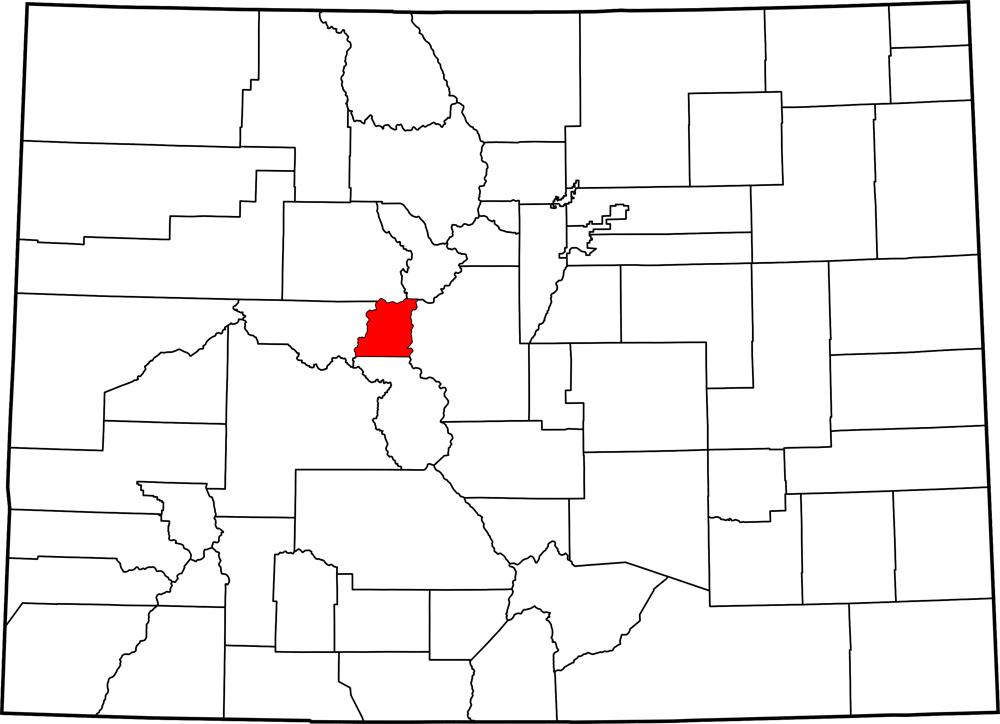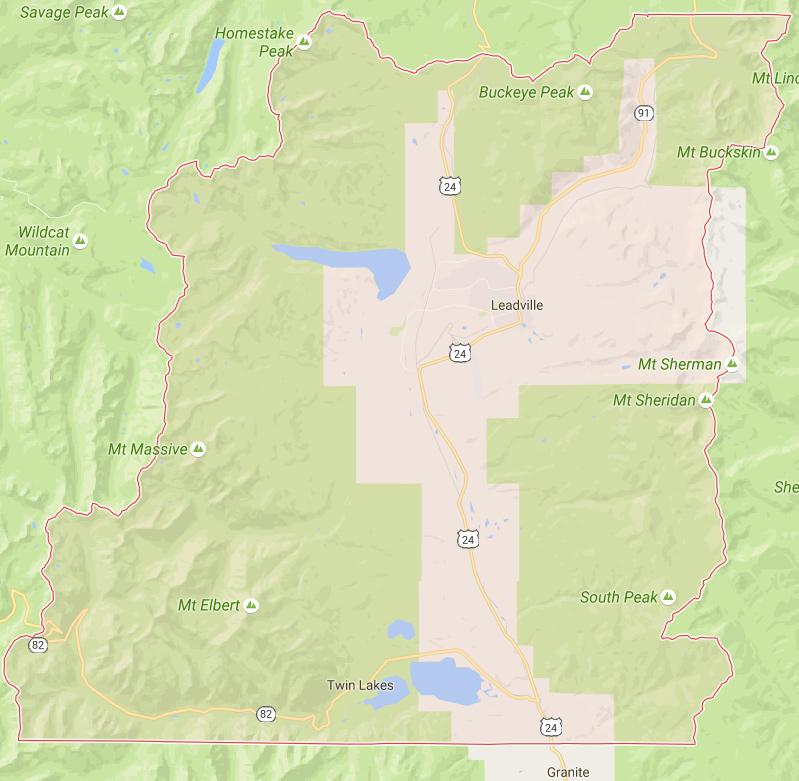Lake County
Full Article
One of Colorado’s original seventeen counties, Lake County is a mountainous, 384-square mile county in the west-central part of the state. Leadville, a historic mining town ringed by tall peaks near the headwaters of the Arkansas River, serves as county seat; at 10,152 feet, it is the highest incorporated city in the United States. The county is home to Mt. Elbert, the highest point in the North American Rockies at 14,440 feet. It is also home to the second-highest point, Mt. Massive, which stands at 14,428 feet. Two other peaks in the county, Mt. Democrat (14,155) and Mt. Sherman (14,043), also qualify as Fourteeners. All of Lake County’s fourteeners are in the Pike-San Isabel National Forest. Other scenic locales in the county include Twin Lakes and Turquoise Lake.
Lake County is bordered by Eagle County to the north, Park County to the east, Chaffee County to the south, and Pitkin County to the west. It has a population of 7,310, with 2,602 people residing in Leadville and the rest spread out in the surrounding rural areas. About 170 live in the small village of Twin Lakes, about twenty miles south of Leadville.
Early History
From about the mid-sixteenth century until the late nineteenth century, the Lake County area was inhabited by a band of Utes called the Parianuche or “elk people.” The Utes hunted elk, deer, and other mountain game, and gathered a wide assortment of berries and roots, such as the versatile yucca root. In the summer and fall they followed game into Lake County’s high country, and in the winter they returned to lower elevations. The Utes continued their seasonal treks across Colorado's high country through the 1860s, when white prospectors arrived as part of the Colorado Gold Rush.
In 1860 the prospector Abe Lee found gold in California Gulch, just south of present-day Leadville. As many as 8,000 people arrived shortly thereafter, and in five years they panned or sluiced out nearly all of the surface gold—worth some $4 million—from the chilly high-country creeks. In 1861 the Territorial Legislature created Lake County, named for the Twin Lakes. Oro City, the name of the first gold-mining camp, was designated the first county seat. Originally an enormous county that stretched from the Arkansas headwaters in the east all the way to the Utah border in the west, the county had by 1879 ceded all of its western land to the creation of Saguache, Hinsdale, La Plata, San Juan, Ouray, and Gunnison Counties.
Silver Mines
A treaty in 1868 pushed the Utes out of the high country surrounding the Arkansas headwaters and paved the way for Leadville’s development, which followed major silver strikes during the 1870s. Most of the early gold miners had left Oro City by 1874, and the town seemed to be on the path toward disappearance. Soon, however, miners discovered that the heavy, gray mineral that so often clogged the gold seekers’ sluices was actually a silver ore.
By 1875 several miners had purchased claims, but they had to wait until a smelter was built to start making any profit. They sent samples to a refining company in St. Louis, and a smelter was built in 1877. Mines sprung up on Iron and Carbonate Hills, and the town of Leadville was established in 1877. In May 1878, two miners discovered another silver lode near Leadville on Fryer Hill. By 1880 the area was the continental center of silver and lead mining, with fifteen smelters and thirty-seven blast furnaces processing millions of dollars’ worth of ore.
Famous Leadville
The silver rush turned around Lake County’s fortunes almost overnight. In the early 1870s, Oro City had a mere 250 people; by the end of the decade, Leadville was the second-largest city in Colorado, with a population approaching 15,000. The rapid and remarkably profitable development of Leadville’s mineral wealth made the town famous, attracting attention from newspapers all over the country, as well as current and former presidents. In 1880, for example, former president Ulysses S. Grant rode the inaugural train into Leadville on the Denver & Rio Grande Railroad.
Horace Tabor, a former gold miner and shopkeeper, had purchased part ownership in the Little Pittsburgh Mine that was established in Oro City. By September 1878, the mine was worth nearly half a million dollars, and the next year Tabor sold his one-third interest for $1 million. In 1880 the Little Pittsburgh Mine ran out of ore, and by 1881 the value of its shares dropped from $34 to $1.50.
Leadville's fame brought more than presidents and mining moguls to the high Rockies. To bolster the nation's supply of game and food fish, the US government established the Leadville National Fish Hatchery at the foot of Mt. Massive in 1889. The hatchery bred Colorado's state fish, the Greenback Cutthroat trout, and has been stocking American waterways for more than 125 years.
Meanwhile, Tabor’s reinvestments in other mines and in Denver real estate made him one of the richest men in the nation. He served as mayor of Leadville and even briefly as a stand-in US senator. However, Tabor’s wealth was always tied to the silver boom, and it disappeared when the mines began to run out and the price of silver crashed in 1893.
Twin Lakes
The town of Twin Lakes, formed near two glacial lakes in southern Lake County, began as the small prospector settlement of Dayton in 1865. Meaningful development did not occur until 1879, when silver booms in Leadville and Aspen turned the area into an important transportation node. That year entrepreneurs John A. Staley and Charles Thomas built a mountain resort on the southern shore of the lakes. The resort floundered, as mining and its associated activities eclipsed tourism in the local economy. But in 1883 Leadville mine owner James Viola Dexter bought the resort, renamed it the Inter-Laken, and transformed it into one of the finest resorts in the Colorado Rockies.
In 1896 the Twin Lakes Reservoir and Canal Company dammed Lake Creek at Twin Lakes to bolster the water supply for farmers in Colorado's eastern Arkansas River valley. The dam dropped the water level in the lakes and made it stagnant, and business at the Inter-Laken declined. The hotel was abandoned in the early twentieth century.
Other Mining Activities
The crash in silver prices during the Panic of 1893 wiped out about 90 percent of the jobs in Leadville. But silver was only one of Lake County’s geologic riches. Before the silver crash was a year old, James Joseph Brown, a mine superintendent and the husband of Margaret “Molly” Brown, found gold in the Little Johnny Mine. Other mines continued to produce zinc, lead, copper, bismuth, iron, manganese, and even silver, although it had lost considerable value.
In the early twentieth century, molybdenum, a metal used in the production of structural steel and other alloys, was discovered north of Leadville and led to the opening of the Climax Molybdenum Mine in 1918. The mine employed about 3,000 people and supplied nearly half of the world’s molybdenum. The Climax Molybdenum Company operated the mine from 1924 to 1987, when its closure again sunk the Leadville area into economic depression. Freeport-McMoRan Copper & Gold announced in 2007 that the mine would resume production, but in 2008 tumbling molybdenum prices led the company to delay its reopening. The Climax Mine finally reopened in 2012 and continues to produce the metal today.
Fryingpan-Arkansas Project
In addition to various mining operations, the twentieth century saw the development of Lake County's water resources as a means to provide water for thirsty farms and cities along the Front Range and the Arkansas River valley in southeast Colorado. One of the main features of the Bureau of Reclamation's Fryingpan-Arkansas Project, begun in 1962, was the creation of dams at Turquoise and Twin Lakes. The project was completed in 1975 and began diverting water in the early 1980s. Ultimately, the Fryingpan-Arkansas Project delivered water to approximately 280,600 acres of irrigated farmland in the Arkansas River valley east of Pueblo; water diverted by the project also helps meet the municipal needs of cities such as Colorado Springs and Aurora.
The conversion of the natural Twin Lakes into a reservoir nearly drowned the historic buildings of the Inter-Laken Resort, but residents got the property listed on the National Register of Historic Places in the 1970s, and the buildings were moved to higher ground. Today, visitors can hike or travel by boat to the Inter-Laken site and explore the historic buildings.
Today
Today, Leadville and Lake County are popular destinations for vacationers, hikers, hunters, campers, and historic tourists. An official Historic Landmark of Victorian Architecture, Leadville boasts some fifty nineteenth-century buildings, a twenty-square-mile historic mining district, and more museums than any other town in the state. The mountains around Leadville are also strewn with abandoned mining structures, such as Hilltop Mine on Mt. Sherman and mining buildings in the now-defunct town of Climax.
Since 1983 Lake County has also been home to the Leadville 100, a grueling, 100-mile footrace across elevations ranging from 9,200 to 12,600 feet. The race takes place each August. Ian Sharman of Bend, Oregon, finished first in the 2016 race with a time of 16 hours, 22 minutes and 39 seconds.






















